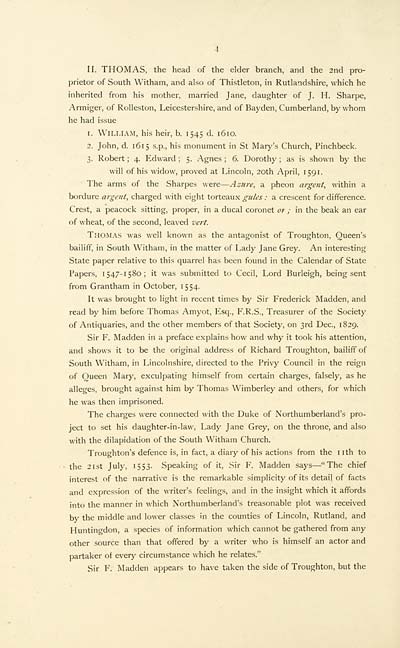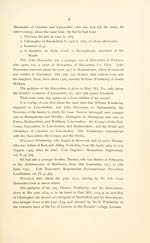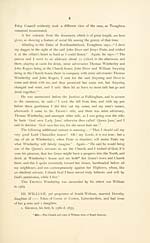Memorials of four old families
(374) Page 4
Download files
Complete book:
Individual page:
Thumbnail gallery: Grid view | List view

II. THOMAS, the head of the elder branch, and the 2nd pro-
prietor of South Witham, and also of Thistleton, in Rutlandshire, which he
inherited from his mother, married Jane, daughter of J. H. Sharpe,
Armiger, of Rolleston, Leicestershire, and of Bayden, Cumberland, by whom
he had issue
i. William, his heir, b. 1545 d. 1610.
2. John, d. 161 5 s.p., his monument in St Mary's Church, Pinchbeck.
3. Robert ; 4. Edward ; 5. Agnes ; 6. Dorothy ; as is shown by the
will of his widow, proved at Lincoln, 20th April, 1591.
The arms of the Sharpes were — Azure, a pheon argent, within a
bordure argent, charged with eight torteaux gules : a crescent for difference.
Crest, a peacock sitting, proper, in a ducal coronet or ; in the beak an ear
of wheat, of the second, leaved vert.
Thomas was well known as the antagonist of Troughton, Queen's
bailiff, in South Witham, in the matter of Lady Jane Grey. An interesting
State paper relative to this quarrel has been found in the Calendar of State
Papers, 1547-1580; it was submitted to Cecil, Lord Burleigh, being sent
from Grantham in October, 1554.
It was brought to light in recent times by Sir Frederick Madden, and
read by him before Thomas Amyot, Esq., F.R.S., Treasurer of the Society
of Antiquaries, and the other members of that Society, on 3rd Dec, 1829.
Sir F. Madden in a preface explains how and why it took his attention,
and shows it to be the original address of Richard Troughton, bailiff of
South Witham, in Lincolnshire, directed to the Privy Council in the reign
of Queen Mary, exculpating himself from certain charges, falsely, as he
alleges, brought against him by Thomas Wimberley and others, for which
he was then imprisoned.
The charges were connected with the Duke of Northumberland's pro-
ject to set his daughter-in-law, Lady Jane Grey, on the throne, and also
with the dilapidation of the South Witham Church.
Troughton's defence is, in fact, a diary of his actions from the nth to
the 21st July, 1553. Speaking of it, Sir F. Madden says — "The chief
interest of the narrative is the remarkable simplicity of its detail of facts
and expression of the writer's feelings, and in the insight which it affords
into the manner in which Northumberland's treasonable plot was received
by the middle and lower classes in the counties of Lincoln, Rutland, and
Huntingdon, a species of information which cannot be gathered from any
other source than that offered by a writer who is himself an actor and
partaker of every circumstance which he relates."
Sir F. Madden appears to have taken the side of Troughton, but the
prietor of South Witham, and also of Thistleton, in Rutlandshire, which he
inherited from his mother, married Jane, daughter of J. H. Sharpe,
Armiger, of Rolleston, Leicestershire, and of Bayden, Cumberland, by whom
he had issue
i. William, his heir, b. 1545 d. 1610.
2. John, d. 161 5 s.p., his monument in St Mary's Church, Pinchbeck.
3. Robert ; 4. Edward ; 5. Agnes ; 6. Dorothy ; as is shown by the
will of his widow, proved at Lincoln, 20th April, 1591.
The arms of the Sharpes were — Azure, a pheon argent, within a
bordure argent, charged with eight torteaux gules : a crescent for difference.
Crest, a peacock sitting, proper, in a ducal coronet or ; in the beak an ear
of wheat, of the second, leaved vert.
Thomas was well known as the antagonist of Troughton, Queen's
bailiff, in South Witham, in the matter of Lady Jane Grey. An interesting
State paper relative to this quarrel has been found in the Calendar of State
Papers, 1547-1580; it was submitted to Cecil, Lord Burleigh, being sent
from Grantham in October, 1554.
It was brought to light in recent times by Sir Frederick Madden, and
read by him before Thomas Amyot, Esq., F.R.S., Treasurer of the Society
of Antiquaries, and the other members of that Society, on 3rd Dec, 1829.
Sir F. Madden in a preface explains how and why it took his attention,
and shows it to be the original address of Richard Troughton, bailiff of
South Witham, in Lincolnshire, directed to the Privy Council in the reign
of Queen Mary, exculpating himself from certain charges, falsely, as he
alleges, brought against him by Thomas Wimberley and others, for which
he was then imprisoned.
The charges were connected with the Duke of Northumberland's pro-
ject to set his daughter-in-law, Lady Jane Grey, on the throne, and also
with the dilapidation of the South Witham Church.
Troughton's defence is, in fact, a diary of his actions from the nth to
the 21st July, 1553. Speaking of it, Sir F. Madden says — "The chief
interest of the narrative is the remarkable simplicity of its detail of facts
and expression of the writer's feelings, and in the insight which it affords
into the manner in which Northumberland's treasonable plot was received
by the middle and lower classes in the counties of Lincoln, Rutland, and
Huntingdon, a species of information which cannot be gathered from any
other source than that offered by a writer who is himself an actor and
partaker of every circumstance which he relates."
Sir F. Madden appears to have taken the side of Troughton, but the
Set display mode to:
![]() Universal Viewer |
Universal Viewer | ![]() Mirador |
Large image | Transcription
Mirador |
Large image | Transcription
Images and transcriptions on this page, including medium image downloads, may be used under the Creative Commons Attribution 4.0 International Licence unless otherwise stated. ![]()
| Histories of Scottish families > Memorials of four old families > (374) Page 4 |
|---|
| Permanent URL | https://digital.nls.uk/95085418 |
|---|
| Description | A selection of almost 400 printed items relating to the history of Scottish families, mostly dating from the 19th and early 20th centuries. Includes memoirs, genealogies and clan histories, with a few produced by emigrant families. The earliest family history goes back to AD 916. |
|---|

